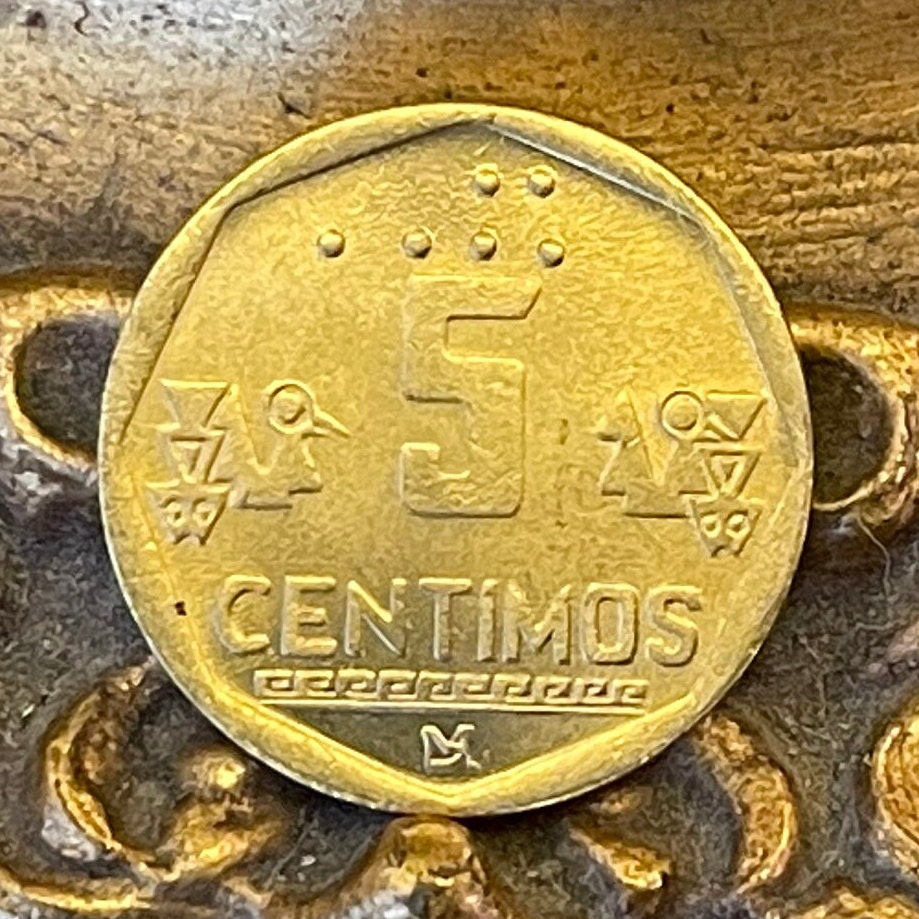elemintalshop
Chimú Bird & Fish Reliefs from Chan Chan 5 Céntimos Peru Authentic Coin Money for Jewelry and Craft Making
Chimú Bird & Fish Reliefs from Chan Chan 5 Céntimos Peru Authentic Coin Money for Jewelry and Craft Making
Couldn't load pickup availability
Chimú Bird & Fish Reliefs from Chan Chan 5 Céntimos Peru Authentic Coin Money for Jewelry and Craft Making
Reverse: Ancient animal reliefs found at the archaeological site of Chan Chan, the capital of the Chimú Empire and largest pre-Colombian city in the Americas near present-day Trujillo.
Lettering: 5 CENTIMOS
Obverse: National arms
Lettering: BANCO CENTRAL DE RESERVA DEL PERU
Features
Issuer Peru
Period Republic (1822-date)
Type Standard circulation coin
Years 2007-2018
Value 5 Céntimos
0.05 PEN = 0.012 USD
Currency Nuevo sol (1991-2015) / Sol (2016-date)
Composition Aluminium
Weight 1.02 g
Diameter 18 mm
Thickness 1.7 mm
Shape Round
Orientation Coin alignment ↑↓
Number N# 7423
References KM# 304.4a, Schön# 103a
Wikipedia:
"Chan Chan is triangular, surrounded by 50–60-foot (15–18 m) walls. There are no enclosures opening north because the north-facing walls have the greatest sun exposure, serving to block wind and absorb sunlight where fog is frequent. The tallest walls shelter against south-westerly winds from the coast. The walls are adobe brick covered with a smooth surface into which intricate designs are carved. The two styles of carving design include a realistic representation of subjects such as birds, fish, and small mammals, as well as a more graphic, stylized representation of the same subjects. The carvings at Chan Chan depict crabs, turtles, and nets for catching sea creatures (such as Spondylus. Chan Chan, unlike most coastal ruins in Peru, is very close to the Pacific Ocean.
*******
Wikipedia:
Chimor (also Kingdom of Chimor or Chimú Empire) was the political grouping of the Chimú culture. The culture arose about 900 AD, succeeding the Moche culture, and was later conquered by the Inca emperor Topa Inca Yupanqui around 1470, fifty years before the arrival of the Spanish in the region. Chimor (Spanish pronunciation: [tʃi'mu]) was the largest kingdom in the Late Intermediate Period, encompassing 1,000 kilometres (620 mi) of coastline.
Late Intermediate Period Cultures
The first valleys seem to have joined forces willingly, but the Sican culture was acquired through conquest. They also were significantly influenced by the pre-Incan Cajamarca and Wari cultures. According to legend, its capital of Chan Chan was founded by Taycanamo, who arrived in the area by sea. Chimor was the last kingdom that had any chance of stopping the Inca Empire. But the Inca conquest began in the 1470s by Topa Inca Yupanqui, defeating the emperor and descendant of Tacaynamo, Minchancaman, and was nearly complete when Huayna Capac assumed the throne in 1493.
The Chimú resided on a strip of desert on the northern coast of Peru. The rivers in the region carved a series of fertile valley plains, which were very flat and well-suited to irrigation. Agriculture and fishing were both very important to the Chimú economy.
Worshipping the moon, the Chimú, unlike the Inca, considered it more powerful than the sun. Offerings played an important role in religious rites. A common object for offerings, as well as one used by artisans, was the shell of the Spondylus shellfish, which resides only in the warm coastal waters off present-day Ecuador. Associated with the sea, rainfall, and fertility, Spondylus shells were highly valued and traded by the Chimú people, and the exchange of the shells played a significant economic and political role in the empire.
The Chimú people are best known for their distinctive monochromatic pottery and fine metal working of copper, gold, silver, bronze, and tumbaga (copper and gold). The pottery is often in the shape of a creature or has a human figure sitting or standing on a cuboid bottle. The shiny black finish of most Chimú pottery was achieved by firing the pottery at high temperatures in a closed kiln, which prevented oxygen from reacting with the clay.
*********
Wikipedia:
Peruvian law describes the coat of arms as follows:
"The arms of the Peruvian Nation shall consist of a shield divided into three fields: one celestial blue to the right, with a vicuna looking inside; other white to the left, with a Cinchona officinalis placed within, and another, red, in the bottom and smaller, with a cornucopia pouring coins, signifying with these symbols the treasures of Peru in the three realms of nature. The coat of arms shall be surmounted by a civic crown in flat view; and accompanied on each side by a flag and a standard of national colors."
Share



















